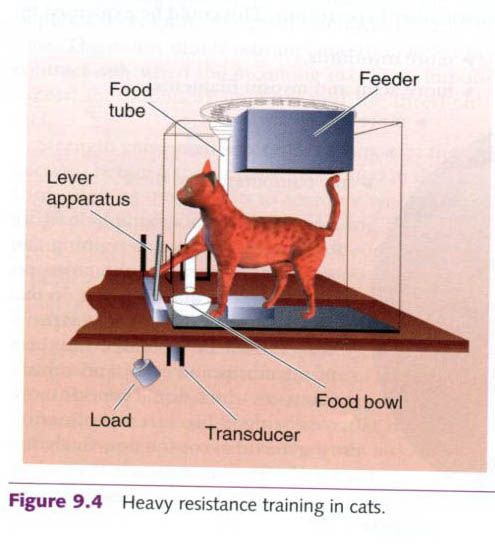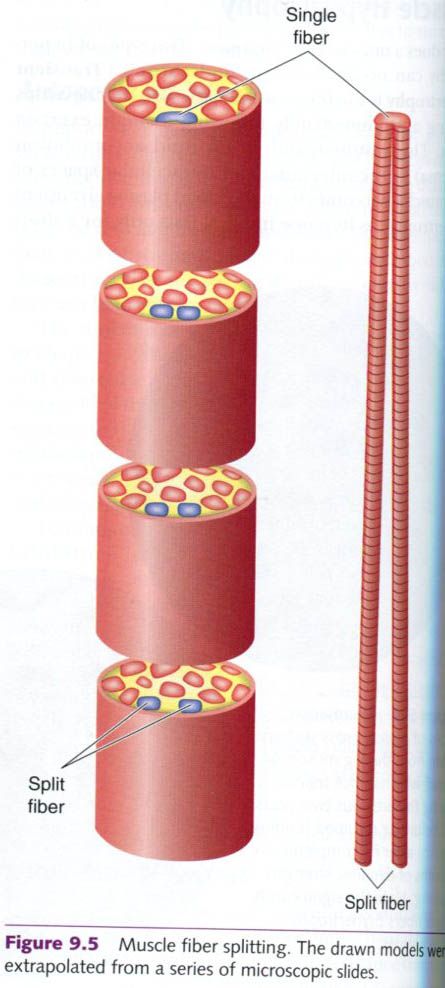They learned to generate considerable force.
With this intense strength training, selected muscle fibers appeared to
actually split in half, and each half then increased to the size of the parent
fiber. This is seen in the cross-sectional cuts through the muscle fibers shown
in figure below.
Subsequent studies, however, demonstrated that
hypertrophy of selected muscles in chickens, rats, and mice that resulted from
chronic exercise overload was attributable solely to hypertrophy of existing
fibers, not hyperplasia. In these studies, each fiber in the whole muscle was
actually counted. These direct fiber counts revealed no change in fiber number.
This finding led the scientists who conducted
the initial cat experiments to conduct an additional resistance training study
with cats. This time they used actual fiber counts to determine if total muscle
hypertrophy resulted from hyperplasia or fiber hypertrophy. Following a
resistance training program of 101 weeks, the cats were able to perform one-leg
lifts of an average of 57% of their body weight, resulting in an 11% increase
in muscle weight. Most important, the researchers found a 9% increase in the
total number of muscle fibers, confirming that muscle fiber hyperplasia did
occur.
The difference in results between the cat
studies and those with rats and mice most likely is attributable to differences
in the manner in which the animals were trained. The cats were trained with a
pure form of resistance training: high resistance and low repetitions. The
other animals were trained with more endurance type activity: low resistance
and high repetitions.
One additional animal model has been used to
stimulate muscle hypertrophy associated with hyperplasia. Scientists have
placed the anterior latissimus dorsi muscle of chickens in a state of chronic
stretch by attaching weights to it, with one other wing serving as the normal
control condition. In many of the studies that have used this model, the
chronic stretch has resulted in substantial hypertrophy and hyperplasia.
Researchers are still uncertain about the roles
played by hyperplasia and individual fiber hypertrophy in increasing human
muscle size with resistance training. Most evidence indicates that individual
fiber hypertrophy accounts for most whole-muscle hypertrophy. However, results
from selected studies indicate that hyperplasia is possible in humans.
In several studies of bodybuilders, swimmers,
and kayakers, substantial muscle hypertrophy has been observed in trained
muscles, but in the absence of individual fiber hypertrophy when compared to
values in untrained control subjects. This suggests that there is a greater
number of muscle fibers in the trained muscles than in the corresponding
musclesof untrained control subjects. However, other studies have shown
individual fiber hypertrophy in highly trained athletes compared to untrained
controls.
In a study of seven previously healthy young
men who had suffered sudden accidental death, the investigators compared cross
sections of autopsied right and left tibialis anterior muscles(lower leg).
Right-hand dominance is known to lead to greater hypertrophy of the left leg.
In fact, the average cross-sectional area of the left muscle was 7.5% larger.
This was associated with a 10% greater number of fibers in the left muscle.
There was no difference in fiber size.
The differences among these studies mighte be
explained by the nature of the training load or stimulus. Training at high
intensities or high resistances is thought to cause greater fiber hypertrophy,
particularly of the type II(fast-twitch) fibers, than training at lower
intensities or resistances.
Only one longitudinal study demonstrated the
possibility of hyperplasia in men who had previous recreational resistance
training experience. Following 12 weeks of intensified resistance training, the
muscle fiber number in the biceps brachii of several of the 12 subjects
appeared to increase significantly. It appears from this study that hyperplasia
can occur in humans, but possibly only in certain subjects or under certain
training conditions.
From the preceding information, it appears that
fiber hyperplasia can occur in animals and possibly in humans. How are these
cells formed? As shown in the previous picture, it is postulated that
individual muscle fibers have capacity to divide and split into two daughter
cells, each of which can then develop into a functional muscle fiber. It has
more recently been established that satellite cells, which are the myogenic
stem cells involved in skeletal muscle regeneration, are likely involved in the
generation of new muscle fibers. These cells are typically activated by muscle
stretching and injury, and, muscle injury results from intense training,
particularly eccentric-action training. Muscle injury can lead to a cascade of
responses, in which satellite cells become activated and proliferate, migrate
to the damaged region, and fuse to existing myofibers or combine and fuse to
produce new myofibers.











0 коментара:
Постави коментар